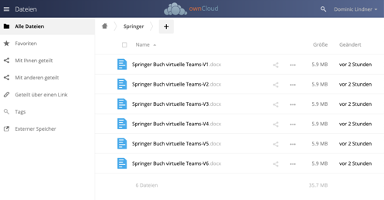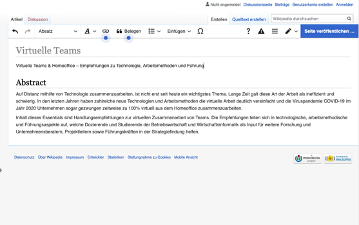In the meantime, there is also a suitable open source counterpart for every commercial software. Open source and free technological equipment for virtual teams is no longer necessarily inferior to the paid applications, but often even represents a comparable solution.
In this article, I would like to explain in more detail what is important here and which factors play an essential role. All information reflects a Summary out Chapter 3.3 of my book Virtual teams and home office from Springer Verlag contrary.
In addition, there is of course also commercial and technological equipment for virtual teams. But I would like to go into this in more detail in another article.
Communication and collaboration software
An example of an open source solution is the owncloud application (see Fig. 1).

Similar to the functions of Microsoft 365, further open source solutions can be obtained that can be integrated into owncloud. Examples are:
- Writing program, tables and presentations (Collabora or Onlyoffice),
- Notes (Joplin),
- Video conference (Jitsi or Kopano),
- Email (Open XChange)
- Chat system (Rocketchat)
- Knowledge documentation (MediaWiki)
- Ticket systems (OTRS and OSTicket),
- Virtual task distribution (Open Office or Kanboard) and
- File sharing (ownCloud).
In addition, it is possible to link the individual components with one another in a meaningful way. Different open source applications can often be connected without any problems (see Fig. 2).

Collabora, Source: Lindner (2020)
In addition, chat and e-mail systems are also of great relevance for open source and free technological equipment for virtual teams. OpenxChange, for example, maps the possibility of a free mail system. Similar to owncloud, it can be operated on your own servers and thus guarantees sovereignty over your own data.
Chat systems are also important communication tools for open source and free technological equipment for virtual teams. The RocketChat system (see Fig. 3), which is easy to integrate into other software components as well as its secure setup and many functions, is particularly popular.

Process and task management software
But there are also suitable open source solutions for managing process and team-based tasks.
Team-based task management: boards and knowledge documentation
One example of this are boards and tools for knowledge documentation. The team-based Kanban board (see Fig. 4), as well as free applications such as OTRS (process-based) or Media Wiki (knowledge documentation), are widely used here.

Using a Kanban board, team-based work can be displayed clearly and transparently. Similar to Jira, various projects can also be created and managed.
Process-based task management: ticket systems
OTRS, on the other hand, describes a web-based ticket system and is therefore a free tool in the area of process-based work (see Fig. 5).

It is particularly suitable for recording, classifying, storing and processing any type of request in a structured manner. With detailed reports for revision security and many other options and functions, it offers many advantages in use.
KNOWLEDGE DOCUMENTATION: Media Wiki
In the area of media wikis you are probably particularly familiar with Wikipedia. Media wikis serve as an interface for collecting and enriching knowledge. In addition, you prevent the creation of multiple versions of a file, since a document can always be edited in the most current version by all employees. An example of a media wiki is shown in Fig. 6 represents:

Sensible linking of the individual software components
In general, it is also important to link all individual software tools in a meaningful way. This can usually be implemented via interfaces (which can be viewed on the manufacturer’s page of the respective tool). Open source applications can also be integrated with commercial applications, so that an individual package can always be put together.
To do this, you should first identify which cross-tool use cases you need in order to be able to organize the work of your virtual team more efficiently. Speaking from my own experience, I can recommend that you ask your employees directly.
Nevertheless, I have listed some useful use cases from my everyday working life for you in the following:
- Documents can be edited and shared directly in the file sharing solution (online office function).
- E-mail attachments are created directly as links from the file sharing solution.
- Documents and tasks (e.g. in Jira) can be linked to one another.
- In the chat, existing documents and tasks can be referred to.
- Automatic creation of a virtual meeting when participants are invited in the calendar
- Automatic absence message for e-mails when vacation is entered in the calendar
- Finally, a link with the time booking, which was not explained in more detail in this chapter: Fast time booking after completing a task or a ticket with transfer of the essential information, e.g. B. Subject.
Conclusion
The advantages of commercial software are often the ease of use as well as the design. Disadvantages can be found when it comes to data protection and the high level of dependency on one provider (vendor lock-in).
Especially in this area, I see open source as much in terms of functionality as commercial solutions and would prefer these due to the sovereignty of the data. In the area of team-based task management, I see commercial software tools currently being developed a little further, and in the area of process-controlled task management, I even see free open source solutions as having an advantage.
Tip: Read my new book: Virtual Teams & Home Office at Springer Gabler or book me for a talk.
Lindner, D. (2020) – Virtual Teams and Home Office – Guide to Technology, Working Methods and Leadership. Springer Verlag
[fotolia]


